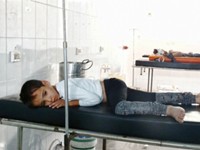Advertisement
Grab your lab coat. Let's get started
Welcome!
Welcome!
Create an account below to get 6 C&EN articles per month, receive newsletters and more - all free.
It seems this is your first time logging in online. Please enter the following information to continue.
As an ACS member you automatically get access to this site. All we need is few more details to create your reading experience.
Not you? Sign in with a different account.
Not you? Sign in with a different account.
ERROR 1
ERROR 1
ERROR 2
ERROR 2
ERROR 2
ERROR 2
ERROR 2
Password and Confirm password must match.
If you have an ACS member number, please enter it here so we can link this account to your membership. (optional)
ERROR 2
ACS values your privacy. By submitting your information, you are gaining access to C&EN and subscribing to our weekly newsletter. We use the information you provide to make your reading experience better, and we will never sell your data to third party members.
Environment
The Devastation Of Chemical Weapons
May 11, 2015
| A version of this story appeared in
Volume 93, Issue 19
The cover story on chemical weapons in World War I was expanded to cite chemical weapon use worldwide, including in contemporary Iran, Iraq, and Syria (C&EN, Feb. 23, page 8). A glaring omission was modern Israel. Israeli-trained terrorists set off white phosphorus bombs in Egypt in 1954, an event known as the Lavon Affair, and Israelis used white phosphorus munitions during the invasion of Lebanon in 1982 and more recently in assaults on Gaza.
Israelis have used tear gas extensively and indiscriminately to suppress Palestinian uprisings in Israeli-occupied territory. An article in the Pittsburgh Press in 1988 reported 11 Arab deaths, mostly very young children and the elderly; more than 1,200 casualties; and dozens of miscarriages from tear gas exposure. The use of the gas in confined areas such as shelters and homes, contrary to its intended use in crowd control, prompted one U.S. manufacturer to suspend sales to Israel.
Max Gergel in his book “Excuse Me Sir, Would You Like To Buy a Kilo of Isopropyl Bromide?” describes seeing chemicals appropriate for the synthesis of nerve gas in a laboratory in Israel. The use of nerve gas against Arabs has been claimed, but in my opinion the evidence is circumstantial. An El Al airliner that crashed in the Netherlands in 1992 was revealed, after years of prodding, to have contained 190 L of dimethyl methylphosphonate, a possible intermediate in nerve gas production.
Finally, Israelis at least since 1972 have frequently defoliated crops of Palestinian farmers in the West Bank in attempts to force them to sell their property.
G. David Mendenhall
Pomona, N.Y.
The article describing the use of chemical weapons in warfare focuses almost exclusively on vesicants used by German and British forces during World War I. But it omits mention of the equally or even more devastating chemical incendiary bombs and flamethrowers used in extensive U.S. and British air attacks on German and Japanese cities and forces during World War II, by U.S. forces in Korea, and by French and U.S. forces in Vietnam.
The most destructive chemical weapon possessed by the WWII Allies was napalm, a highly flammable, sticky jelly consisting, in its original configuration, of a gel of gasoline thickened with two aluminum soaps: aluminum naphthenate and aluminum palmitate. In later years, it was used as a formulation comprising a gel of gasoline, benzene, and polystyrene.
Some idea of the death and destruction produced by these chemical weapons can be gained from looking at the results of the firebombing of Hamburg, Germany, carried out in seven massive raids by coordinated British and U.S. forces in July and August of 1943. The impact on the ground included a firestorm reaching winds of 150 mph and temperatures of 800 °C. Casualties numbered 42,000 dead and 37,000 wounded. In the city, 214,000 of a total of 414,000 houses were destroyed.
Manfred E. Wolff
Laguna Beach, Calif.



Join the conversation
Contact the reporter
Submit a Letter to the Editor for publication
Engage with us on Twitter